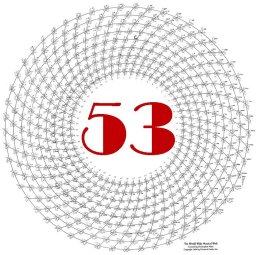Next Page: 4/5 – Creating Just Intervals, Chords
The Unique Partials of the Harmonic Series
Every whole number is a partial, but the prime numbers take you into new harmonic territory. The others are simply combinations of two lower partials. For example, the 18th harmonic is a multiple of the perfect fifth and octave, but the 19th harmonic is mathematically and sonically unique. Here are the unique, prime-number harmonics, in the octave-reduced ratios (the actual ratios of the harmonics themselves are 2:1, 3:1, 5:1, 7:1, 11:1, etc.) The cents in pure just, cents in 53-eq, how to notate these harmonics, and how to get from any starting note to its prime-number harmonic are also included. The best 53-eq approximations (within 3 cents) are for the 3rd, 5th, 13th, 37th and 41st. The 7th harmonic is 4.5 cents off, which is audible but tolerable (to me). The 11th harmonic is an intolerable (to me) 8 cents off, which makes 53-eq something of a seven-limit tuning system, unless you choose to bypass the 11th harmonic relationships and go straight to the ethereal 13th harmonic (three cents off). As you go into higher harmonics beyond the 7th, the 53-eq tuning system is often rather unsuitable….
Figure 4-4 Partials of the Harmonic Series (all the way to the 61st harmonic in 53-eq)
If you would like to learn more about this chapter, “The Unique Partials of the Harmonic Series” including detailed descriptions of all the harmonics up to the 61st and which ones do and don’t approximate well in 53-equal, you can buy the entire book, The Grand Unified Theory of Music, in pdf form for $25 with hundreds of embedded musical examples of scales and chords from all over the world.
A free introduction to what The Grand Unified Theory of Music offers is on this website and includes both text and a few musical examples from each webpage. If you would like to learn more about this chapter and the full contents of this entire e-book, you can buy The Grand Unified Theory of Music for $25, with hundreds of embedded musical examples of scales and chords from all over the world — and ideas for how to set up your computer system —
HERE.
You’ll get a personalized password you can use to see the entire e-book. Inside the full book, you will also get a link to the complete pdf file of this e-book, which you can read on your Kindle or similar device. The links to the hundreds of mp3 sound files – the same ones you can hear on the website — will also be included. This is “Version 1.0” of The Grand Unified Theory of Music. Because it is an e-book, additions, corrections and improvements in the sound may be added at any time. The Grand Unified Theory of Music is Copyright © 2018 by Christopher Mohr. All rights reserved.
One person per password. Sharing this password with others is a violation of copyright. Do not allow others to use your password or link to the pdf file!
